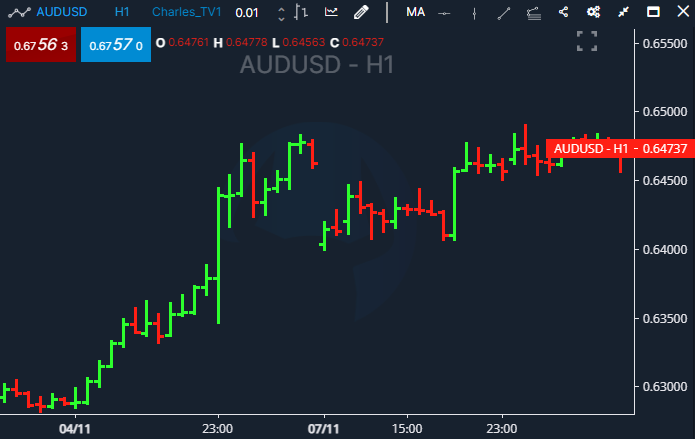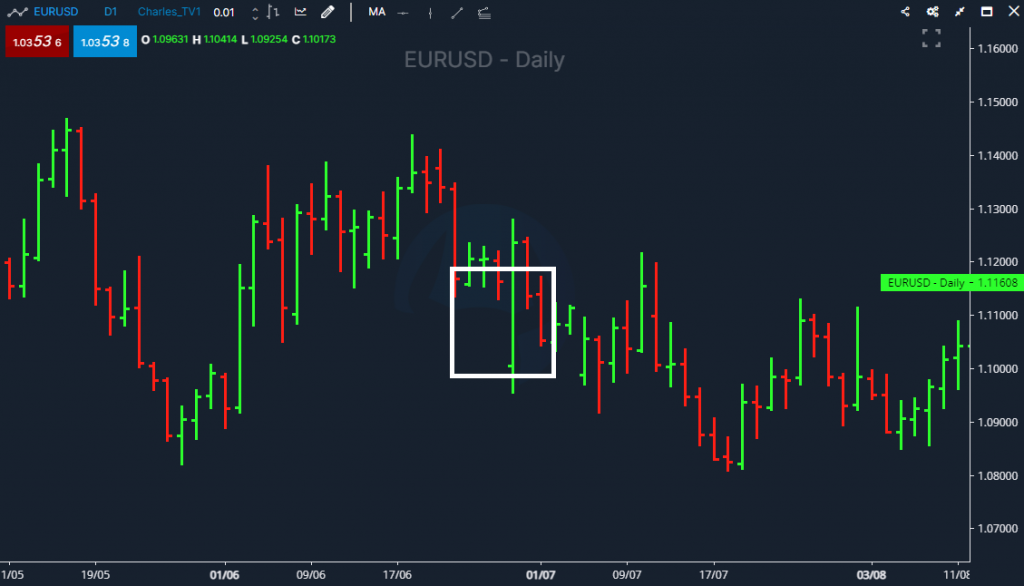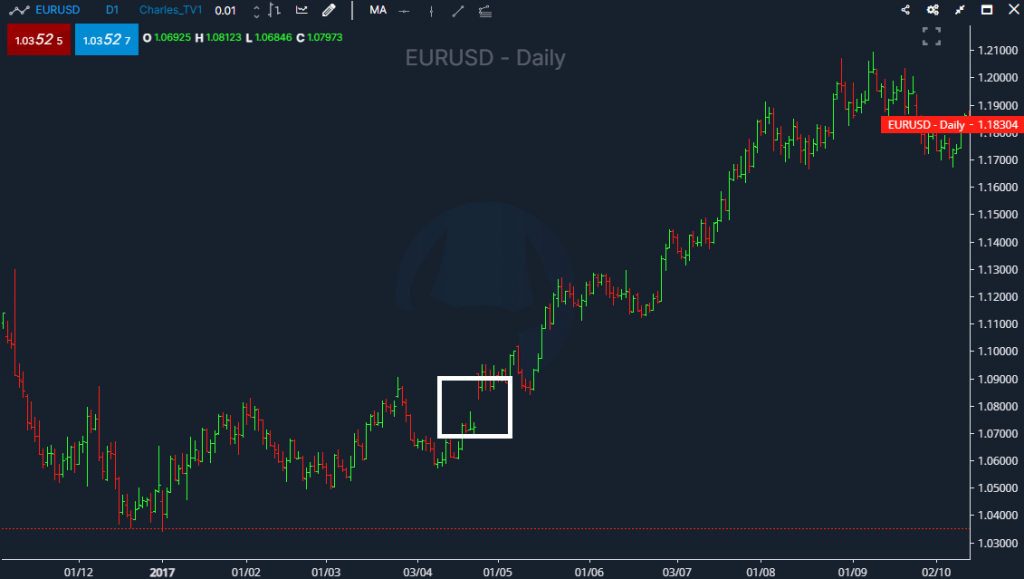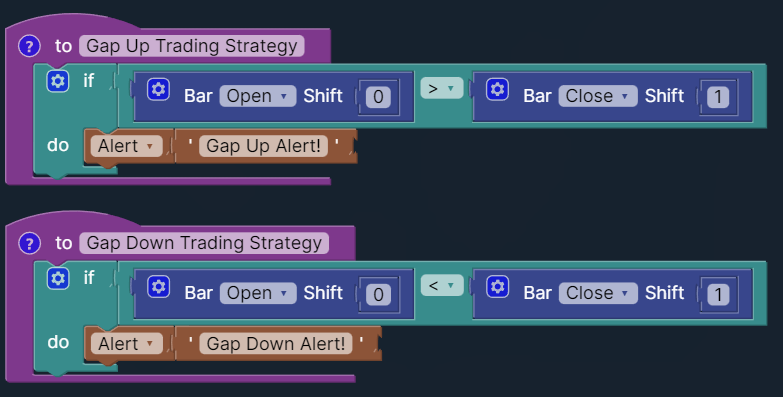Fill the Gap trading strategy. Gap and Go trading.
Have you ever sat in front of your trading screen and noticed a financial instrument open at a much higher or lower level, after a seemingly consistent pattern on a chart? If you have, then what you have observed is called a gap in the market which comes with its own gap trading strategy.
Most traders would consider a gap like this as being a market movement far beyond their control, but as you will soon discover, experienced traders can use probabilities to identify the best opening gap and trade range setups.
Are you looking for a gap up and gap down swing trading strategy?
Morning gap trading strategies? or an Overnight gap trading strategy?
In post we will cover how to trade gaps with automation:
- What is a gap up or gap down?
- Types of gaps
- Why do gaps occur?
- What are some typical gap patterns?
- How to automate a gap trading strategy?
- How to use gaps as part of a trading strategy?
- The best gap trading strategies
- How do we manage the trade?
What is a gap?
On a daily chart, typically a gap occurs when a financial instrument closes at one level the previous day, and then opens at a much higher or lower level than the previous high or low. See Figure 1 (Full gap down).

Types of gaps
For trading purposes, gaps can be defined as one of the following:
Full Gap Up – When the opening level is higher than the previous day’s high.
Full Gap Down – When the opening level is lower than the previous day’s low.
Partial Gap Up – When the opening level is higher than the previous days close, but not higher than the previous day’s high.
Partial Gap Down – When the opening level is lower than the previous days close, but not lower than the previous day’s low.
Why do gaps occur?
Gaps mainly occur when the particular instrument and/or market, in general, makes an announcement that is unexpected, or a related event somewhere in the world takes place.
Recent examples:
The markets factored in a slow but possible European recovery, but then all of a sudden this view was shaken by the Italian election results, with the possibility of an anti-austerity party coming into power.
This was not expected, and on Monday morning when the markets commenced trading, the negative sentiment of the Euro crisis was back in the limelight. This led to a pessimistic market view that saw the S&P fall by 43 points in 6 hrs.
If the underlying conditions don’t call for such a move, in this case just a change in sentiment, then a reversal of the move or “filling the gap” is highly likely, which is exactly what happened in this case.

Another more recent example is the idea of a Cypriot tax on bank deposits. The reason why this is seen as being so negative is the possible domino effect that it will have on other countries in the region.
This change of sentiment transpired into the markets. The S&P had a gap of 10 points on this occasion but filled its gap later that day.

Similarly, in the Forex and Equities markets, gaps are common occurrences when relevant reports and announcements are released.
What are some typical gap patterns?
These are the most common gap patterns:
Breakaway – You can see these patterns occur usually during the end of a price pattern, this could also mean the start of a new trend.
Continuation – Is a common occurrence when people feel they have missed out and rush to buy/sell the move, usually seen in the middle of the pattern.
Common – These follow no price pattern, they just show a gap in the price.
Exhaustion – Are usually a last effort at trying to reach higher highs or lower lows.
Note: these patterns are only evident after the pattern has concluded, which has little guidance for trading.
How to automate a gap trading strategy?
Using Trade View X-Builder you can create automated gap trading strategies within a few minutes, like below.
If the bar opens above the previous bar close, it has formed a gap up, and an alarm will trigger. Alternatively this can be created into an automated trading strategy using the buy blocks provided.

How do we use gaps as part of a trading strategy?
We use a systematic approach to perform an analysis of how far a gap needs to be before it becomes viable for our trading strategy.
Let’s take a look at a common gap trading scenario using the ASX 200.
The first thing we do is filter out the overnight data and focus only on the data that was created during the primary session between 9:50 am – 4:30 pm. The reason for this is that it gives a much truer reflection of the closing price.
Next, in considering the underlying factors behind the gap (just like we mentioned earlier with Italy and Cyprus), we need to make sure that the selling pressure slows down before entering the trade.
We do this by watching for consolidation, and this can be achieved by watching market depth and noticing price action and volume around potential support and/or resistance levels.
We then look at creating a volatility based entry rule by using an ATR (Average True Range). For the purpose of the example we will use a 0.5 ATR.
Then we observe the market open at 9:50 am for the first 10 – 20 minutes. During this period, we are looking for the price of the ASX200 to be either above the 0.5 ATR or below the 0.5 ATR.
If the price is above 0.5 ATR then you would look to go short.
If the price is below 0.5 ATR then you would look to go long.
How do we manage the trade?
It is crucial to have a good risk management system in place (i.e. what happens if we get the trade wrong and the gap continues in the same direction?). This is where most traders fail to be prepared, which often leads to oversized losses.
Since the system we use is a volatility based one, not only do we use an ATR to trigger our trade entry level, but we also use it in determining our exit or stop loss level.
The stop loss is placed at a suitable distance away from the entry point, as many times gaps will tend to take a leg down/up and will prematurely exit trades if the stop loss is too close. We may typically set this at 2 or 2.5 x ATR.
Another method we may use is to set the stop loss at 1.5 or 2 x initial gap distance, so if the original gap is 80 points then your stop could be 120 or 160 points.
Daily monitoring of the position
The next important step is to monitor the trades three times throughout the day:
Morning – 10 am to 12 pm
During this time we look to keep the stop loss at the original level
Afternoon – 12 pm to 2 pm
During this time we look to trail the stop loss in line with the market’s movement, but still keeping it at our same initial stop distance
Afternoon – 2 pm – 4 pm
During this time we look to make the stop loss much tighter or near the market, and then trailing it from that point.
The final step in our gap trading system is to overlay a filter so that we don’t get stuck in a market that is trend neutral.
One way is to place a Moving Average over the daily time frame and use one of the following rules:
If price is above MA – longs only
If price below MA – shorts only
Continuous gap trading refinement
What we have outlined is a guide to using a gap trading system in most markets, but of course extra knowledge is required in order for this system to be implemented and managed correctly.
Although gap trading is one of many successful trading strategies used by professional traders, it is still very important to get professional support in designing your own system and testing it before putting it into practice.
Identifying the type of gap you are trying to trade could be the difference between being profitable or losing money. There are always risks that any trade could go bad. Every gap trading system needs to be constantly adjusted for optimal use.
At Trade View Investments we offer trading system development as part of our overall Systems Building Workshops.
Let us know how we can help you take the next step in your trading today.Please contact us for more information.
If you would like to learn more about creating automated trading strategies check out the Trading Talk series.
Why wait? Get started today. Sign up for an account today with our partnered broker.
I attended your Gap Trading webinar a couple of weeks ago and I was highly impressed with the information you shared. Is it possible to get the webinar as a recording so I can go over the content again?
Hi Luke,
Yes you can, we will send you a link to your e-mail.
Thanks again